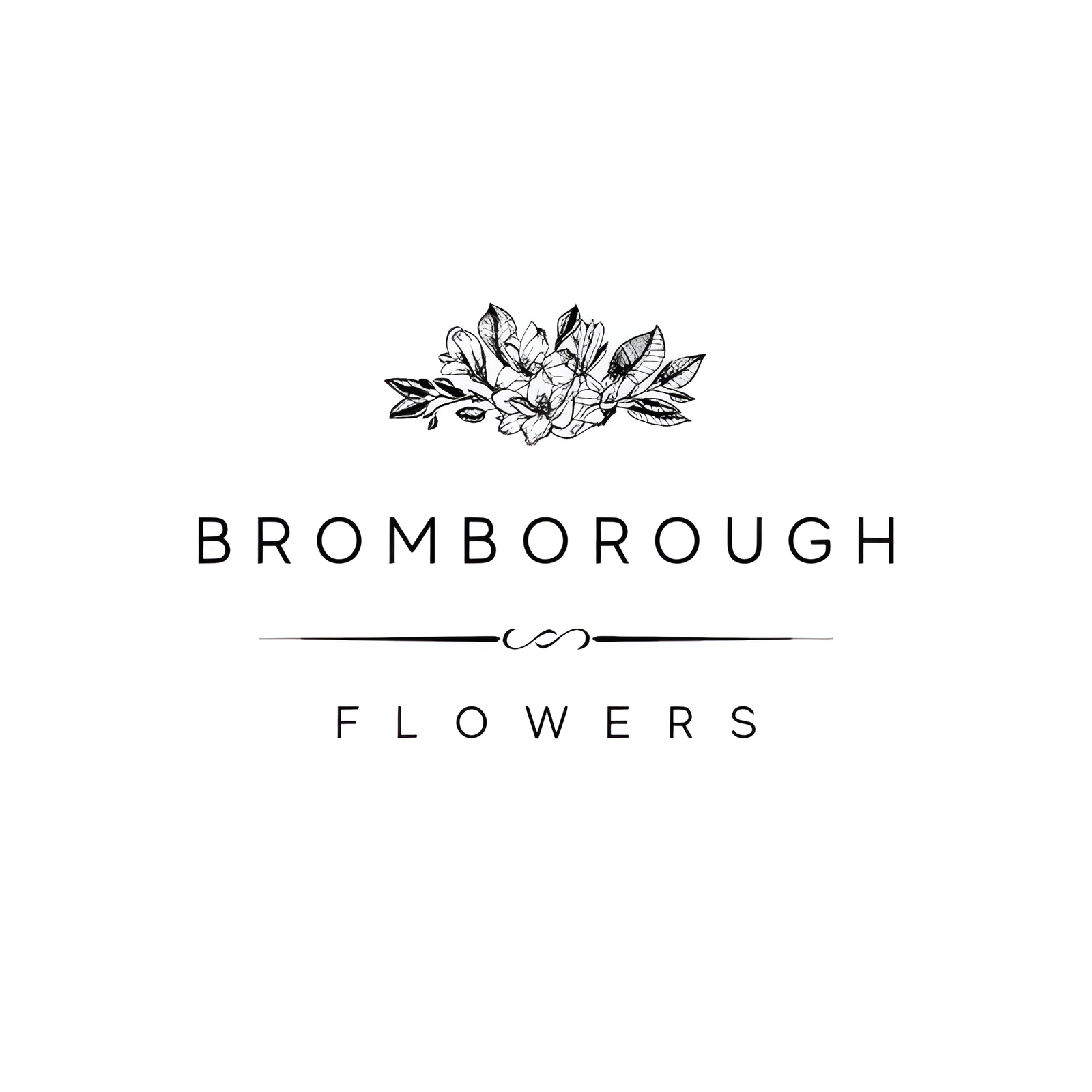When planning a wedding, selecting the appropriate floral arrangements can greatly improve the overall aesthetic, and the Jacaranda flower offers an outstanding option. With its eye-catching blue-violet tones and intricate, fern-like leaves, Jacaranda flowers bring both grace and refinement to wedding decor. Coming from South America and flourishing in sunny climates, this drought-resistant bloom is not only visually pleasing but also functional for summer ceremonies. To learn how Jacaranda can enhance your wedding day, from bouquets to centerpieces, and uncover its special cultural importance, keep reading our detailed guide.
Flower Overview
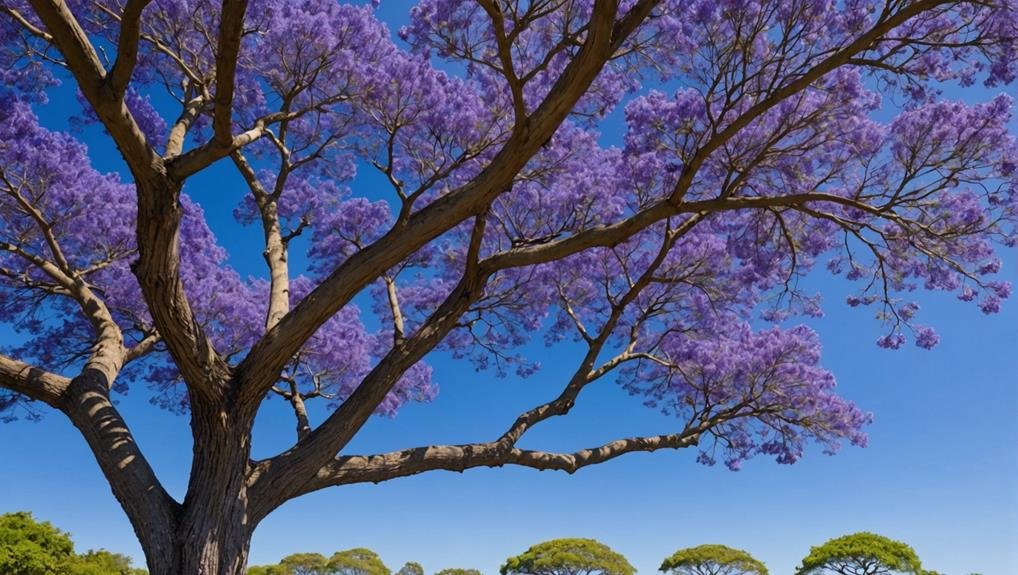
The Jacaranda tree, native to South America, is celebrated for its enchanting blue-violet flowers and fern-like foliage, making it a popular choice for enhancing garden aesthetics. With its striking visual appeal, the Jacaranda tree has become an increasingly favored element in wedding floral arrangements. The tree's blooms, characterized by their vibrant blue-violet hue, add a unique and alluring touch to wedding decor, offering an alternative to traditional wedding flowers.
Jacaranda trees are not only visually appealing but also practical for use in weddings. Their flowers are drought-tolerant and low-maintenance, which ensures that they stay fresh and vibrant throughout the event. Additionally, the tree's long blooming period during the summer months provides a reliable source of blossoms for weddings planned in warm, sunny climates. This extended blooming season means that couples can enjoy the beauty of Jacaranda flowers without worrying about their availability.
Incorporating Jacaranda flowers into wedding arrangements can evoke a sense of natural elegance and historical significance, given the tree's lifespan of up to 50 years. This longevity symbolizes enduring love and commitment, making Jacaranda flowers a meaningful choice for wedding ceremonies and receptions.
Physical Description
Renowned for their distinctive blue-violet flowers and fern-like foliage, Jacaranda trees can grow between 25-50 feet tall and 15-30 feet wide. These imposing trees are not only visually striking but also serve practical purposes, such as providing a wide canopy for shade. With a lifespan of up to 50 years, Jacarandas are a long-term commitment to any landscape, offering historical significance and enduring beauty.
The fern-like foliage of the Jacaranda tree adds a delicate, airy texture that complements its vibrant blossoms. These trees thrive in warm, tropical, or subtropical climates with full sun and well-drained soil, making them ideal for regions that support such conditions. Their low maintenance and drought tolerance once established make Jacarandas an attractive option for those looking to add a touch of elegance without extensive upkeep.
In the context of a wedding day, incorporating Jacaranda elements can create a unique and memorable atmosphere. The tree's spectacular blooms attract wildlife, infusing natural charm into wedding decor. Whether used as a backdrop or as part of floral arrangements, Jacarandas offer a distinctive and enchanting aesthetic that can elevate any wedding celebration.
Available Colour Varieties
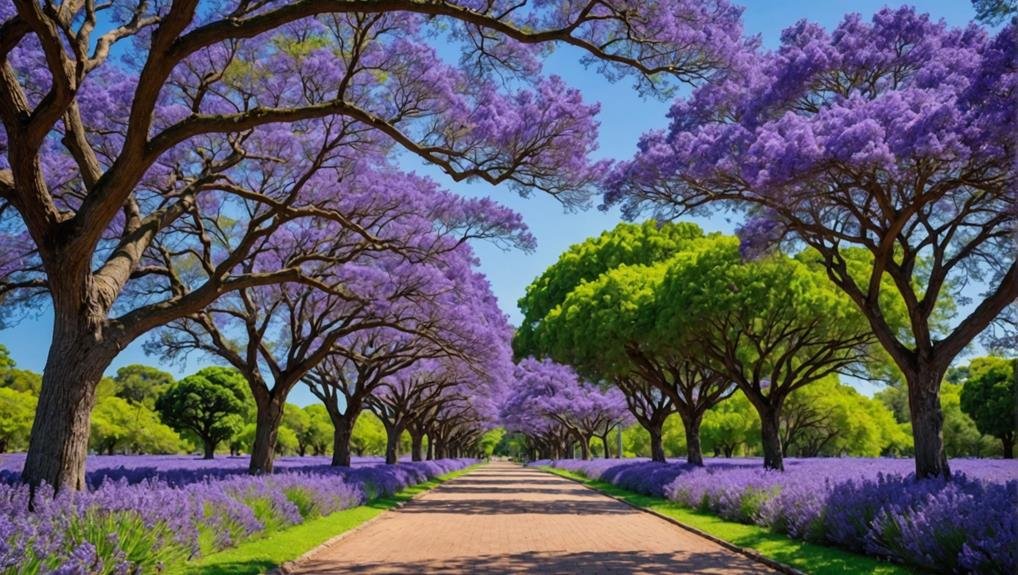
Jacaranda flowers are primarily celebrated for their striking purple-blue hue, but they also offer subtle variations that can enhance wedding floral arrangements. These flowers are known for their vibrant shades, which symbolize elegance and beauty, making them an ideal choice for bridal bouquets and centerpieces. The tree prefers warm climates, where it thrives and produces an abundance of these enchanting blooms.
While the classic purple-blue is the most recognized, Jacaranda flowers come in a few other subtle color variations that can complement various wedding themes:
- Lavender: A softer, more delicate shade that pairs well with pastel wedding palettes.
- Pale Blue: An understated hue that adds a touch of serenity to arrangements.
- Light Purple: Slightly lighter than the classic shade, providing a more gentle and romantic feel.
- White: Rare but striking, white Jacaranda flowers can offer a pure and elegant look.
- Bi-Colored: Some variations exhibit a beautiful blend of blue and white, adding a unique touch.
These color options allow for creative combinations with other blooms, enhancing the overall aesthetic of wedding decor.
Regardless of the choice, Jacaranda flowers bring a touch of royalty and sophistication to any wedding setting.
Latin Name and Taxonomy
Jacaranda mimosifolia, known for its vibrant blue-violet flowers, belongs to the Bignoniaceae family. This species is celebrated for its fern-like foliage and ornamental appeal. The Latin names and naming conventions of plants play a pivotal role in botanical classification, providing a universal language for identifying and discussing plant species.
The taxonomic hierarchy of Jacaranda mimosifolia places it within the Plantae kingdom, under the Angiosperms division and the Lamiales order. This classification underscores the genetic relationships and species diversity within the Bignoniaceae family. Although the genus 'Jacaranda' includes various species, Jacaranda mimosifolia remains the most renowned due to its striking floral display and widespread use in landscaping.
Below is a detailed table outlining the taxonomic hierarchy of Jacaranda mimosifolia:
| Category | Classification | Details |
|---|---|---|
| Kingdom | Plantae | Broadest category in plant taxonomy |
| Division | Angiosperms | Flowering plants with enclosed seeds |
| Order | Lamiales | Includes a variety of flowering plants |
| Family | Bignoniaceae | Known for trumpet-shaped flowers |
| Genus | Jacaranda | Encompasses multiple species |
| Species | Jacaranda mimosifolia | Known for its distinctive blue-violet flowers |
Understanding the botanical classification and taxonomic hierarchy helps in appreciating the genetic relationships and diversity within the Jacaranda genus.
Geographical Origins
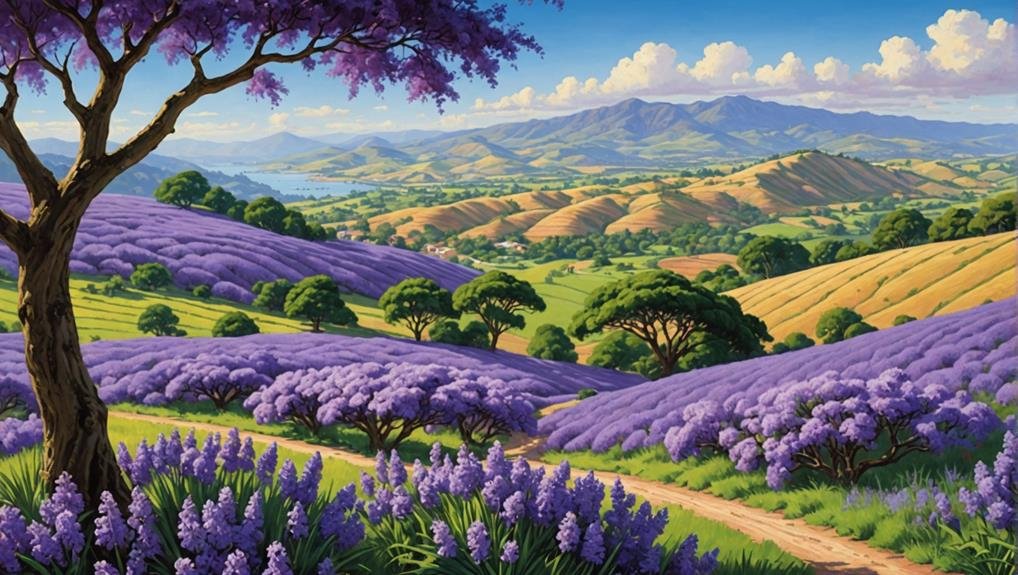
Originating from Argentina, Jacaranda trees are celebrated for their vibrant purple, lilac, and light blue flowers. These visually striking trees were introduced to Buenos Aires in the 19th century and have since become an integral part of the city's identity, symbolizing its rich history and cultural heritage. Designated as Buenos Aires' distinctive tree in 2015, Jacarandas attract numerous tourists who visit in November to witness their spectacular blooms.
The geographical origins of Jacaranda trees are closely tied to the warm regions near water bodies such as the Paraná River and the Río de la Plata. Their adaptability and non-damaging roots make them ideal for urban landscaping, contributing significantly to environmental impact and aesthetic appeal. The trees are not only valued for their beauty but also for their historical significance, as they have been part of the city's landscape for over a century.
- Indigenous to Argentina, especially prevalent along the Paraná River.
- Introduced to Buenos Aires in the 19th century.
- Designated as Buenos Aires' distinctive tree in 2015.
- Ideal for urban landscaping due to non-damaging roots.
- Substantial historical and cultural symbolism.
Thus, Jacaranda trees remain a celebrated feature in both natural and urban settings.
Season Availability
Blooming mainly from October to April, the season of Jacaranda trees' vibrant floral display significantly enhances the aesthetic appeal of parks and gardens. These trees are renowned for their distinct lilac, light blue, and purplish-blue flowers, which create a visually stunning tableau during their blooming season. The blooming patterns of Jacaranda trees are typically observed in the summer months, with November often marked as a peak period when tourists flock to regions adorned with these magnificent blooms.
The climate requirements for Jacaranda trees play an important role in their seasonal availability. They thrive in warm, frost-free environments, making them particularly suited to subtropical and tropical regions. This preference for warmer climates explains their regional popularity in areas such as Buenos Aires, where they have been designated as distinctive trees since 2015. The cultural significance of Jacarandas in such regions further elevates their status, making them a beloved feature in public and private landscapes alike.
Understanding the season availability of Jacaranda trees is vital for those considering their use in wedding arrangements. Their peak blooming period from October to April ensures that they can provide a breathtaking floral element to weddings held during these months.
Growing Conditions
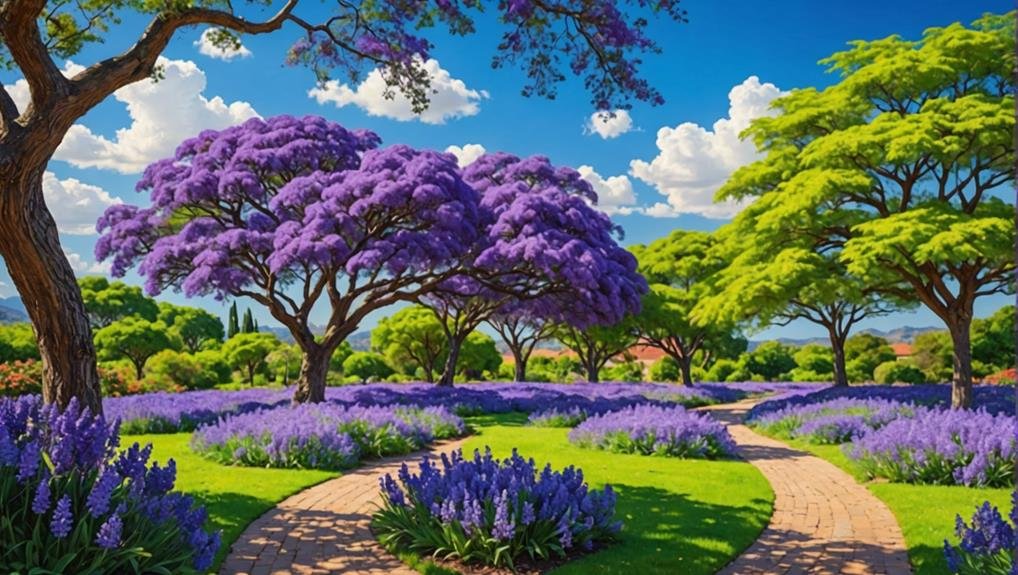
Thriving in warm, tropical, or subtropical climates, these trees need abundant sunlight and well-drained soil to prevent waterlogging and root rot. Jacaranda trees are moderately drought-tolerant once established, making them a resilient choice for suitable environments. Their soil preferences include a liking for sandy, loamy soils that promote effective drainage.
Jacarandas also thrive under full sun exposure, requiring at least six hours of direct sunlight daily to support their vigorous growth. The ideal temperature range for best growth is between 60°F and 80°F, as these trees are sensitive to frost and extreme cold.
To maintain healthy growth, it is crucial to follow a suitable watering schedule, especially during the tree's early years. Regular watering is vital until the tree is well-established, after which it can tolerate drier conditions.
The growth rate of Jacarandas is relatively rapid, with the potential to reach heights of 25-50 feet and widths of 15-30 feet. Pruning techniques should be used sparingly, primarily to eliminate dead or damaged branches, ensuring the tree maintains its natural shape.
- Soil preferences: Sandy, loamy, well-drained
- Watering schedule: Regular until established, then drought-tolerant
- Sunlight requirements: Full sun, six hours daily
- Temperature range: 60°F to 80°F
- Growth rate and pruning methods: Fast growth, minimal pruning
This thorough understanding of Jacaranda growing conditions guarantees their successful cultivation and lasting beauty in gardens.
Cultural Significance
The Jacaranda tree holds profound cultural significance in Argentina, symbolizing both the nation's historical origins and the aesthetic charm of its urban landscapes. Indigenous to the region, the tree's striking purple-blue flowers have become emblematic of Argentina's rich heritage.
The Jacaranda was introduced to Buenos Aires in the 19th century with the aim of beautifying the city, a mission it has certainly achieved. This tree has graced Buenos Aires' parks and streets, adding not only to the city's natural beauty but also its historical storyline.
Since 2015, the Jacaranda has been designated as Buenos Aires' distinctive tree, highlighting its importance in the city's urban scenery. The seasonal bloom of the Jacaranda in November transforms the cityscape into a picturesque display of lilac and purplish-blue tones. This occurrence has become a significant tourist attraction, attracting visitors from around the globe to witness the city bathed in vibrant colors.
The presence of Jacaranda trees in urban areas hence serves as a cultural landmark, enhancing the aesthetic appeal of the surroundings while celebrating Argentina's historical origins and symbolism. Their striking seasonal bloom continues to enchant both locals and tourists alike.
Typical Use in Weddings
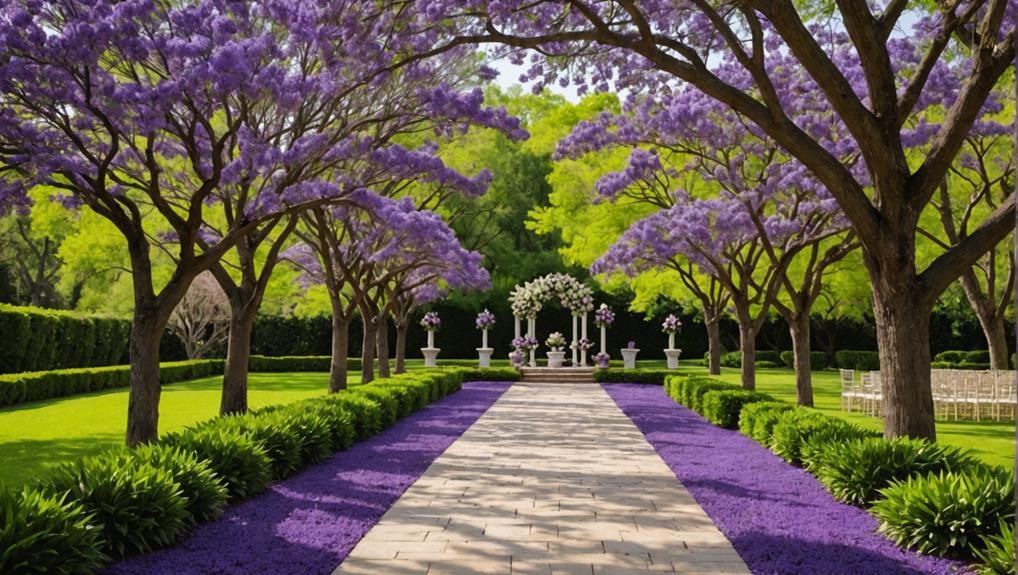
Renowned for their vibrant purple-blue hue and unique appearance, Jacaranda flowers are frequently incorporated into weddings to enhance the elegance and beauty of bridal bouquets, centerpieces, and floral arrangements. These stunning blooms not only add a touch of sophistication but also symbolize love, beauty, and prosperity, making them a meaningful choice for such a special occasion.
Jacaranda flowers can be utilized in various aspects of wedding decor, providing a cohesive and picturesque aesthetic:
- Jacaranda in bridal hairpieces: Delicate petals woven into hairpieces or crowns create a graceful and romantic look for the bride and bridal party.
- Jacaranda as table decorations: Sprigs of Jacaranda blossoms can adorn guest tables, adding a pop of color and elegance to the reception setting.
- Jacaranda in wedding arches: Incorporating these flowers into wedding arches adds a breathtaking and memorable backdrop for vows and photographs.
- Bridal bouquets: Jacaranda flowers can be a focal point or accent in bridal bouquets, offering a unique and eye-catching element.
- Centerpieces: Arrangements featuring Jacaranda blooms can serve as stunning centerpieces, enhancing the overall ambiance of the wedding venue.
The versatility and charm of Jacaranda flowers guarantee they remain a favorite among brides and florists, contributing to unforgettable wedding celebrations.
Alternative Flower Types
Exploring alternative flower types for weddings can offer diverse and equally enchanting options to Jacaranda blossoms. Ceibo, Lupins, Tulips, Sunflowers, Lavender, and Peonies each bring unique qualities to wedding decor, enriching the ambiance with their distinctive characteristics.
Ceibo flowers, adorned with a rich cultural legend of Anahí, thrive along rivers, adding an exotic touch to wedding settings. Known for their eye-catching petals, Ceibo blooms from October to April, making them a versatile choice. Lupins, marking the spring beginning in Patagonia, are celebrated for their antioxidant properties and vibrant hues, ideal for creating lively floral arrangements.
Tulips, with their rainbow colors, provide a striking visual against snow-capped mountains from October to November, perfect for a picturesque wedding backdrop. Sunflowers symbolize prosperity and joy, often celebrated in a national festival in February and reaching impressive heights, making them a statement piece in any floral decor. Lavender, with its soothing scent, offers a calming and aromatic addition, while Peonies, known for their romantic elegance, remain a timeless choice for wedding bouquets.
| Flower Type | Unique Feature |
|---|---|
| Ceibo | Legend of Anahí, river growth |
| Lupins | Spring beginning, antioxidants |
| Tulips | Rainbow colors |
| Sunflowers | Prosperity, national festival |
| Lavender | Soothing scent |
| Peonies | Romantic elegance |
Each of these flowers provides a distinctive flair, ensuring your wedding day blooms with beauty and significance.
